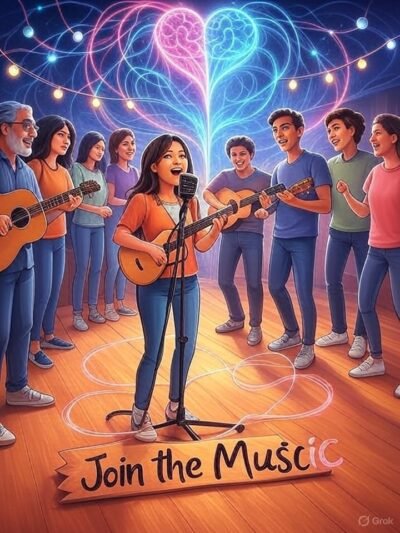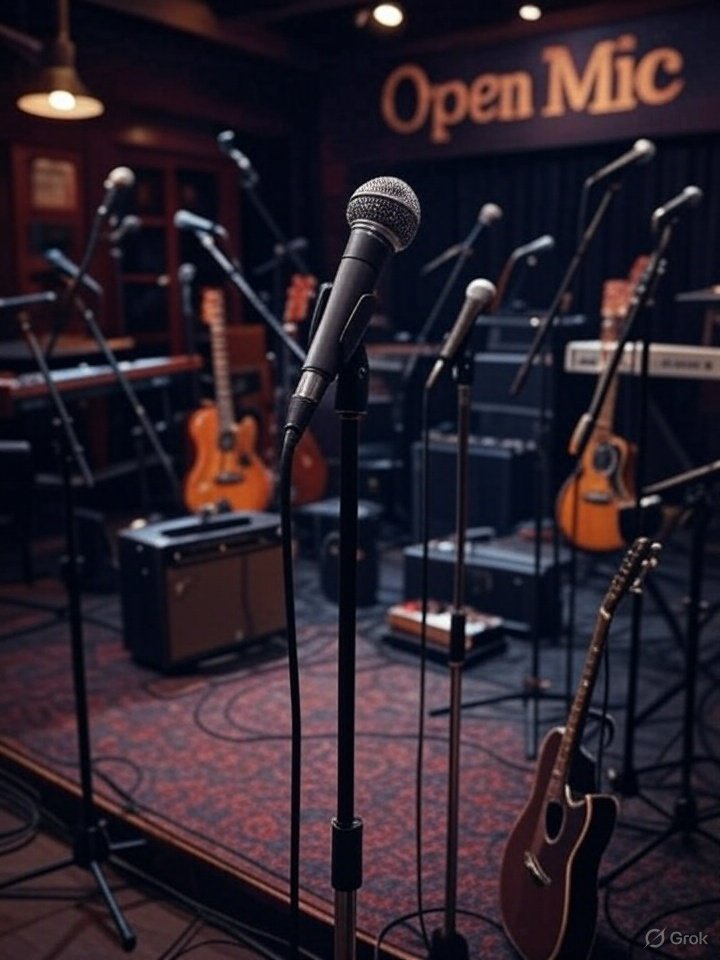Blog/Experiences
Join the Music: Science Shows Singing, Playing, or Simply Experiencing Live Music Boosts Both Your Physical and Mental Well-Being

If you’ve ever felt the urge to sing along at an open mic night, hum quietly to yourself—even just under your breath—or tap your foot at a live show, science says you should follow that feeling. Research from around the world shows that both making music—whether singing, playing, or even just humming—and listening to music, especially live performances, offer powerful benefits for your mind, body, and sense of community.
Music Boosts Mood and Mental Health
Studies consistently find that music, even when simply listened to, can reduce anxiety, lower blood pressure, ease pain, and improve sleep quality, mood, and memory. Making music yourself, whether singing, humming, or playing an instrument, further enhances these effects by increasing feelings of mastery, self-esteem, and social connection. Research also shows that both music treatments and activities—including listening and active music-making—significantly reduce stress-related outcomes like anxiety and heart rate across diverse populations.
A review in Harvard Health notes that music therapy is being used more and more to help treat depression, anxiety, and even chronic pain. Numerous studies show that musical activities can improve outcomes for people recovering from illness or surgery, with evidence indicating that patients listening to music before, during, or after cardiac surgery experience lower stress hormone levels and less anxiety. Its use continues to expand as evidence for its benefits grows.


The Unique Power of Live Music
While listening to recorded music is beneficial, more and more studies are showing that hearing music performed live—especially in smaller, more intimate settings—is even more therapeutic. A 2016 study published in Public Health found that attending live music events was linked to higher levels of well-being and life satisfaction, with the effect strongest among people who attended smaller, more frequent performances rather than large concerts. Additional research confirms that live music attendance boosts well-being by fostering social identity and connectedness, particularly in smaller venues where audience interaction is higher.
Researchers suggest that live music’s impact comes from the shared social experience, the immediacy of the performance, and the emotional connection between audience and performer. Another study from University College London found that people who attended live music in small venues reported reduced stress and increased feelings of belonging and happiness compared to those who only listened to music at home. Further studies highlight that smaller, community-based performances enhance happiness and reduce stress through shared emotional experiences.
Making Music Changes the Brain
Music doesn’t just feel good—it actually changes your brain. Engaging with music triggers the release of chemicals like dopamine, which is linked to pleasure and motivation. Research further shows that music listening and performance activate reward centers in the brain, enhancing motivation and emotional well-being. Learning or practicing music builds new neural connections, a process called neuroplasticity, which helps keep the brain resilient and sharp as we age. Studies also indicate that music training strengthens neural connectivity in areas tied to memory, attention, and motor skills, benefiting people across all ages.

A 2023 literature review highlights that music training can boost memory, attention, and learning, and that even listening to music can stimulate brain regions involved in emotion and cognition. Another study found that rhythmic music, especially when enjoyed, can improve focus, disrupt negative thought patterns, and increase overall health.

Social Benefits: Music Brings People Together
One of music’s most powerful effects is its ability to unite people. Making music in a group—like singing at an open mic, humming along with friends, or playing in a jam session—creates a sense of belonging and strengthens social bonds. Research shows that group music-making can lower stress hormones, increase oxytocin (the “bonding” hormone), and foster feelings of trust and closeness. Studies also reveal that group singing promotes rapid social bonding, even among strangers, by boosting oxytocin levels and reducing stress.
Even simple activities, like humming along or tapping to the beat with others, can make people feel more connected. Additional research highlights that group music performance increases social closeness and even elevates pain tolerance through endorphin release, enhancing community ties. That’s why open mic nights and live performances are about more than just entertainment—they’re opportunities to build community and support both physical and mental well-being.
The Takeaway: No Experience Needed
You don’t have to be a professional musician to reap these rewards. Studies show that the benefits of music are accessible to everyone, regardless of skill level. Research also reveals that even amateur group singing fosters social bonding and improves mental health, proving that simply joining in delivers powerful rewards. The key is participation and enjoyment—so whether you sing, hum, play, or just listen, joining in is what counts.
Ready to boost your mood, sharpen your mind, and connect with your community? Join the music—science says you’ll be glad you did.

References
For readers interested in further exploration, the following studies and sources cited in this article provide in-depth research on the subject:
American Psychiatric Association. (2023). The Transformative Power of Music in Mental Well-Being. https://www.ncbi.nlm.nih.gov/pmc/articles/PMC10410837/
Chanda, M. L., & Levitin, D. J. (2013). The neurochemistry of music. Trends in Cognitive Sciences, 17(4), 179-193. https://psycnet.apa.org/record/2013-10071-001
Clift, S., & Hancox, G. (2010). The perceived benefits of singing: findings from preliminary surveys of a university college choral society. Journal of the Royal Society for the Promotion of Health, 128(2), 73-78. https://journals.sagepub.com/doi/10.1177/1466424007087804
Creech, A., Hallam, S., Varvarigou, M., McQueen, H., & Gaunt, H. (2013). Active music making: A route to enhanced well-being among older people. Perspectives in Public Health, 133(1), 36-43. https://journals.sagepub.com/doi/10.1177/1757913912466950
Daykin, N., et al. (2018). Music, singing and wellbeing in healthy adults. BMJ Open, 8(2), e020151. https://bmjopen.bmj.com/content/8/2/e020151
Fancourt, D., & Steptoe, A. (2016). Community group membership and multidimensional subjective well-being in older age. Public Health, 137, 58-65. https://www.sciencedirect.com/science/article/abs/pii/S0033350615004654
Fancourt, D., Warran, K., & Aughterson, H. (2019). Singing, wellbeing and health: context, evidence and practice. In G. Welch, D. Howard, & J. Nix (Eds.), The Oxford Handbook of Singing. Oxford University Press. https://academic.oup.com/edited-volume/28125
Grape, C., Sandgren, M., Hansson, L. O., Ericson, M., & Theorell, T. (2003). Aerobic singing and humming: Effects on heart rate variability and well-being. Integrative Physiological and Behavioral Science, 38(1), 65-74. https://link.springer.com/article/10.1007/BF02734262
Global Wellness Institute. (2025). Music for Health and Wellbeing Initiative Trends for 2025. https://globalwellnessinstitute.org/wellnesstrends2025/
Harvard Health Publishing. (2015). Can music improve our health and quality of life? https://www.health.harvard.edu/blog/can-music-improve-health-quality-life-201509258363
Johns Hopkins Medicine. (2020). Keep Your Brain Young with Music. https://www.hopkinsmedicine.org/health/wellness-and-prevention/keep-your-brain-young-with-music
Koelsch, S. (2014). Brain correlates of music-evoked emotions. Nature Reviews Neuroscience, 15(3), 170-180. https://www.nature.com/articles/nrn3666
Koelsch, S. (2023). Biological principles for music and mental health. Nature Reviews Neuroscience, 24(1), 17-31. https://www.nature.com/articles/s41583-022-00653-3
Livesey, L., Morrison, I., Clift, S., & Camic, P. M. (2012). Benefits of choral singing for social and mental wellbeing: Qualitative findings from a cross-national survey. Journal of Public Mental Health, 11(1), 10-26. https://www.emerald.com/insight/content/doi/10.1108/17465721211207275/full/html
MacDonald, R., Kreutz, G., & Mitchell, L. (Eds.). (2012). Music, Health, and Wellbeing. Oxford University Press. https://global.oup.com/academic/product/music-health-and-wellbeing-9780199586974
National Center for Complementary and Integrative Health. (2022). Music and Health: What You Need To Know. https://www.nccih.nih.gov/health/music-and-health-what-you-need-to-know
Sage Journals. (2025). Live Music for Mental Health: A Pilot Study of How Concerts Reduce Stigma and Increase Social Connectedness. https://journals.sagepub.com/page/jmt/music-and-mental-health
University College London. (2018). Study on live music and well-being. https://www.ucl.ac.uk/news/2018/jan/study-live-music-and-well-being
Viola, E., Martorana, M., Airoldi, C., et al. (2023). The role of music in promoting health and wellbeing: a systematic review and meta-analysis. European Journal of Public Health, 33(4), 738–745. https://academic.oup.com/eurpub/article/33/4/738/7207338
Levitin, D. J., & Chanda, M. L. (2013). Music as medicine. American Psychological Association Monitor, 44(10). https://www.apa.org/monitor/2013/11/music
Nature. (2023). Biological principles for music and mental health. https://www.nature.com/articles/s41398-023-02671-4
Harvard Health. (2021). Music and health. https://www.health.harvard.edu/newsletter_article/music-and-health
ScienceDirect. (2021). Music, mental health, and immunity. https://www.sciencedirect.com/science/article/pii/S2666354621001683
Sage Journals. (2023). Health Benefits of Music: Psychology of Music. https://journals.sagepub.com/doi/full/10.1177/03057356221129837
Altenmüller, E., & Schlaug, G. (2015). Apollo’s gift: New aspects of neurologic music therapy. Progress in Brain Research, 217, 237-252. https://www.sciencedirect.com/science/article/abs/pii/S0079612314000283
de Witte, M., Spruit, A., van Hooren, S., Moonen, X., & Stams, G. J. (2020). Effects of music interventions on stress-related outcomes: A systematic review and two meta-analyses. Health Psychology Review, 14(2), 294-324. https://www.tandfonline.com/doi/full/10.1080/17437199.2019.1627897
Lamont, A., & Ranaweera, N. A. (2020). Knocking on heaven’s door: The social-psychological effects of attending live music events. Musicae Scientiae, 24(3), 362-377. https://journals.sagepub.com/doi/10.1177/1029864918798545
Pearce, E., Launay, J., & Dunbar, R. I. M. (2015). The ice-breaker effect: Singing mediates fast social bonding. Royal Society Open Science, 2(10), 150221. https://royalsocietypublishing.org/doi/10.1098/rsos.150221
Perkins, R., Yorke, S., & Fancourt, D. (2018). How group singing facilitates social bonding and mental health: A mixed-methods study. Medical Humanities, 44(4), 241-246. https://mh.bmj.com/content/44/4/241
van der Vliet, M. M., van den Boom, A. L., & Finkenauer, C. (2022). Live music attendance and subjective well-being: The role of social identity and connectedness. Psychology of Music, 50(6), 1872-1886. https://journals.sagepub.com/doi/10.1177/03057356211058668
Weinstein, D., Launay, J., Pearce, E., Dunbar, R. I. M., & Stewart, L. (2016). Group music performance causes elevated pain thresholds and social bonding in small and large groups of singers. Evolution and Human Behavior, 37(2), 152-158. https://www.sciencedirect.com/science/article/abs/pii/S1090513815001040
Zatorre, R. J., & Salimpoor, V. N. (2013). From perception to pleasure: Music and its neural substrates. Proceedings of the National Academy of Sciences, 110(Supplement 2), 10430-10437. https://www.pnas.org/content/110/Supplement_2/10430
